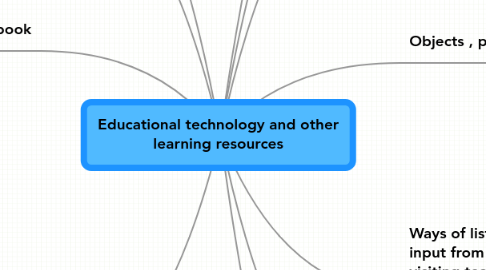
1. A soft ball to make learning
2. Many classrooms world do not have access to modern technology.
3. the technology pyramid
3.1. Represent different realities in a "reversed pyramid
3.1.1. language laboratories
3.1.2. whiteboards
3.1.3. nothing
4. There is a lot we can do with minimal or even no resources.
4.1. paper bags with faces draw on them baceme puppets.
5. Objects , pictures and things
5.1. REALIA
5.1.1. for a creative activitie
5.2. PICTURES
5.2.1. Drills: lower. level students
5.2.1.1. flashcards useful grammar items
5.2.2. Games: for communication
5.2.2.1. students can have a conversation
5.2.3. Prediction: to predict what is coming.
5.2.3.1. look at picture and try to guess what it shows.
5.3. CARDS
5.3.1. Matching and ordering: cards are good for matching questions and answers
5.3.1.1. Using cards for kinesthetic learners.
5.3.2. Card games:There are many card games possibilities in language learning.
5.3.2.1. we can turn the card selection into a game by introducing a competitive element.
5.4. CUISENAIRE RODS
5.4.1. The rods are featureless and are only differentiated by their length and colour.
5.4.1.1. Rods can be used to teach prepositions.
6. The most useful resources in the classroom are students themselves.
6.1. We can get them write or talk about things they like or things they have experienced.
7. The coursebook
7.1. Methodologist have been arguing about the usefulness of coursebooks questioning their role.
7.2. Benefits: the coursebooks are carefully prepared to offer a coherent syllabus, satisfactory language control, audio cassettes and extra resource material
7.3. Restrictions: the coursebooks. Used inappropriately, impose learning styles and content on classes and teacher alike.
7.4. Using coursebooks: the most important aspect of course book use is for teachers to try engage students with the content.
7.5. Omit and replace: the first decision we have to make is whether to use a particular coursebook lesson or not.
7.6. To change or not change: we might decide to use the lesson but to change it to make it more appropiate for our students.
8. Ways of showing
8.1. The board
8.1.1. The most versatile piece of classroom teaching equipement.
8.1.2. Note-pad: write things up on the board as these come up during the lesson.
8.1.3. Explanation aid: we can show the relationship between an affiemative sentence and a question by drawing connecting arrows.
8.1.4. Picture frame: boards can be used for drawing pictures
8.1.5. Game board: there are a number of games with noughts and crosses. Also called Tic-Tac-Toe
